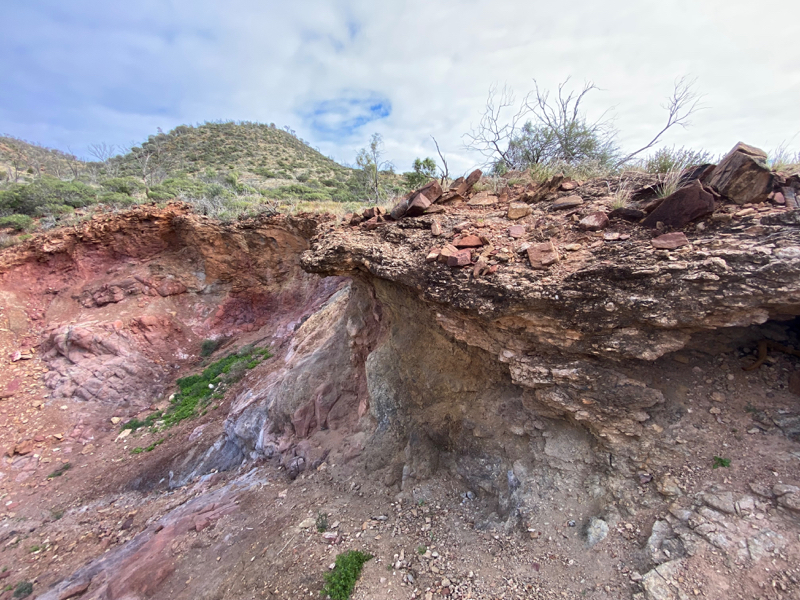This outcrop of nodular limestone can be seen 4km into Bunyeroo Creek from the road. Part of the Wilkawillina Limestone Formation (dating 530 million years ago), the origins of this lumpy limestone remain a mystery.


This outcrop of nodular limestone can be seen 4km into Bunyeroo Creek from the road. Part of the Wilkawillina Limestone Formation (dating 530 million years ago), the origins of this lumpy limestone remain a mystery.




This 80m long creek bank in Parachilna Gorge exposes colourful sedimentary laminae (1-25mm wide) of the Bunyeroo Formation.
As outlined in The Legacy of Time: The Story of the Flinders Ranges by the Royal Geographical Society of South Australia, the layers are likely to have been formed by marine deposition of fine-grained silts following the end of an ice age (650ma). The vertical bedding exposes micro-faults and folding that occurred during the formation of the Blinman dome.
The site is easily accessed on the northern bank of the creek at the turn-off to Glass Gorge Rd from Parachilna Gorge Rd.

The Ajax Limestone in the Northern Flinders Ranges includes a significant array of Lower Cambrian Archaeocyath fossils, replaced by quartz, exposed in ground-level limestones.
This fossil site on a low gibber-covered rise to the north of Beltana represents the most species-diverse archaeocyath locality worldwide, with a count of 82 species. One of seven sites in the Flinders Ranges currently under consideration for UNESCO World Heritage status, it provides a significant record of an extinct group of marine sponges (Phylum Porifera) that lived around 525 million years ago and played a dominant role in constructing the first reefs on Earth.



The Skillogalee Dolomite is a 750 million-year-old formation that is host to stromatolite fossils – the only evidence of complex living organisms at that time. Stromatolites are fossilised biochemical accretionary structures created by Cyanobacteria (‘blue-green algae’) colonies which form microbial mats and laminated mounds in shallow saline waters. Living stromatolites are found at the tip of the Yorke Peninsula (SA) and Shark Bay in (WA).

Skillogalee Dolomite includes blue-grey dolomites, magnesites, bands of black cherts and stromatolites. Magnesites (magnesium carbonate) of this formation were formed in marginal lagoons of the Adelaide Geosyncline around 750 million years ago and occur as beds, commonly conglomerate in texture, as pictured below.



A geological unconformity is an unconformable contact between two different lithologies. In the case of this formation in Jubilee Creek in the Northern Flinders Ranges, stromatolitic limestone of the Balcanoona Formation overlays laminated mudstone of the Tapley Hill Formation.
These two formations followed the melting of an ice age dating 700 million years ago. “Black silt, rich in fine organic material derived from algae and bacteria, was deposited as laminations (each less that 0.5mm thick) in the calm shelf sea. The total thickness of this silt blanket (known as the Tapley Hill Formation) increased from a few tens of metres in the west to about 3km in the ranges east of Hawker. Here depth of water and rate of subsidence of the basin floor were greatest. As silt built up, the water around the margins of the basin became shallow enough for stromatolites and oolite banks to form; these are exposed near Port Augusta and Balcanoona [Balcanoona Formation].” – Excerpt from The Legacy of Time: The Story of the Flinders Ranges by the Royal Geographical Society of South Australia.

Mt Neill Granite is exposed in a rocky creek near Paralana Hot Springs. The red feldspars of this 1580 million year old formation present in a variety of forms.



This lightweight Kaolinitic Granite at NE Arkaroola is an alteration of Mt Neil Granite. Hydrothermal fluids have destroyed the micas and replaced the feldspars of the original granite (1580 million years old) with Kaolinite.

For more information on how to locate this site, see Geological Field Excursion Guides.
The Wooltana Volcanics formation (830 million years ago) is visible on exiting Claude Pass on the Paralana Road at Arkaroola.


For more information on how to locate this site, see Geological Field Excursion Guides.
Ripple marks, mud cracks and rain drop imprints indicate a shallow aquatic environment when the sediments of the Wortupa Quartzite formation were deposited around 790 million years ago.


For more information on how to locate this site, see Geological Field Excursion Guides.